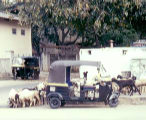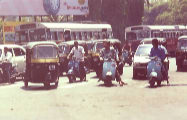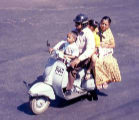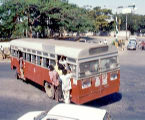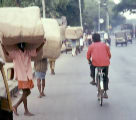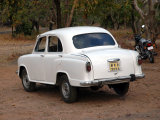Click on one of the small images to see a larger version.
Traffic
This information is from 1995, but I've been told the current situation is much the same. In most cities, you would take a taxi to get around. In Bangalore, you take an auto rickshaw. Imagine a three-wheeled
motorcycle with a bench seat in the rear, a metal shell, and a soft canopy. There are no doors or seatbelts. Actually, just look at the photos below. They are efficient (about 80 miles per gallon) and maneuverable.
The drivers are remarkably skilled, weaving through traffic at 30 mph with only inches of clearance.
It took a while to get used to that! Most auto rickshaws were owned by their driver, who generally decorated the rear exterior with a painting. These paintings were often landscapes and quite beautiful.
I see from the recent videos (below) that these paintings are a lost art that have been replaced by actual rear windows in what are now metal canopies. Given how many people usually cram into
one, I can't imagine that the driver can actually see out of the rear window..
Traffic in Bangalore was a real eye-opener for me. All manner of animals and vehicles share the road. Bulls, cows, and goats and often seen in the road. Vehicles including bicycles, motor scooters, motorcycles,
auto-rikshaws, cars, small trucks, buses, and very large trucks all shared the road. The traffic laws appear to be:
- Obey traffic lights
- Honk your horn when about to pass, when passing, and when otherwise in the mood
- The lines marking off the lanes are for decoration only, even if they indicate a separation of traffic moving in opposite directions
- Yield to anything bigger than you are
If a road has three lanes in each direction, you might see one truck, a motor scooter, two auto rickshaws, and a car riding abreast. Basically, whatever fits.
Traffic routinely expands into lanes normally for the use of oncoming traffic when those lanes are otherwise unoccupied.
I learned how to drive on the streets of New York City and on the freeways of New Jersey, I've driven in Boston and Washington D.C., and thought I knew how to drive...until I got to Bangalore. Those people treat every trip as if it were a stock car race. If cruise control were available on the vehicles there, I doubt they would sell a single unit.
Traffic routinely expands into lanes normally for the use of oncoming traffic when those lanes are otherwise unoccupied.
I learned how to drive on the streets of New York City and on the freeways of New Jersey, I've driven in Boston and Washington D.C., and thought I knew how to drive...until I got to Bangalore. Those people treat every trip as if it were a stock car race. If cruise control were available on the vehicles there, I doubt they would sell a single unit.
Given what I saw in 1995, it was hard to imagine offering such a luxury as cruise control on a car. I didn't see many cars when I was there, but the videos (below) are more
recent and show not only more cars, but also a much wider variety of models. Most people used the auto rickshaws or any of a variety of two-wheeled vehicles. (An interesting result of the economies of
labor vs. manufactured goods there is that anyone who can afford a car can easily afford a driver, so cars are rarely driven by their owners.)
Automatic transmission, air conditioning, and even radios were considered to be very advanced features. Things such as power windows were almost unheard of. Until fairly recently the manufacturing of automobiles was heavily regulated by the government, and there were only two or three brands. The vast majority of the cars I saw there were comparable to American cars from the 1940's and 1950's, but designed and manufactured in India. The Hindistan Motors' Ambassador is typical of this type. A relatively new brand on the scene is a venture of Suzuki known as Maruti. They offer far more modern-looking cars starting at only $6,000. That's about half the cost of the least expensive car in America. I saw some imports on the roads, but not many. Almost all were Mercedes. I hear that some 50 models of car, including Ford Escorts, are now available in India, so the automotive scene has changed significantly since I was there. However, the traffic has only gotten worse. One improvement is that the recent videos (below) don't show bullock carts and goats on the roads, whereas they were not unusual when I was there.
Automatic transmission, air conditioning, and even radios were considered to be very advanced features. Things such as power windows were almost unheard of. Until fairly recently the manufacturing of automobiles was heavily regulated by the government, and there were only two or three brands. The vast majority of the cars I saw there were comparable to American cars from the 1940's and 1950's, but designed and manufactured in India. The Hindistan Motors' Ambassador is typical of this type. A relatively new brand on the scene is a venture of Suzuki known as Maruti. They offer far more modern-looking cars starting at only $6,000. That's about half the cost of the least expensive car in America. I saw some imports on the roads, but not many. Almost all were Mercedes. I hear that some 50 models of car, including Ford Escorts, are now available in India, so the automotive scene has changed significantly since I was there. However, the traffic has only gotten worse. One improvement is that the recent videos (below) don't show bullock carts and goats on the roads, whereas they were not unusual when I was there.
The traffic engineers in Bangalore are very fond of traffic circles (also known in some places as "roundabouts". Each circle has signs (at ground level) prominently displaying the name of the circle,
but no signs at all indicating which roads intersect there or to identify any of the paths out of the circle. The philosophy must be that either you know where you are going or you shouldn't be driving.
Safety is not a primary concern. No vehicles have seat belts (or emissions controls). Most vehicles could never pass inspection in the US for any of dozens of reasons. While an auto rickshaw can comfortably carry three people, they often carry more. I once saw a family of eight people and a small goat getting out of one! Entire families often ride on one motor scooter, with only the husband having a helmet. Buses often run with people hanging out of the doors or merely holding onto the exterior. After dark, driving with headlights off is not at all unusual.
One must be careful not to make judgments about another culture, especially one that has a written history starting over 1,500 years before North America was even discovered. I feel that my perspective on many things was substantially broadened and altered by my visit to India. It is hard to put into words what a profound effect being so immersed in a culture so different from my own has had on me. I treasure my visit to India, and look forward to bringing my wife and our daughter Surya back to visit there once being an American overseas isn't quite as dangerous as it is while Bush/Cheney are running our government.
Safety is not a primary concern. No vehicles have seat belts (or emissions controls). Most vehicles could never pass inspection in the US for any of dozens of reasons. While an auto rickshaw can comfortably carry three people, they often carry more. I once saw a family of eight people and a small goat getting out of one! Entire families often ride on one motor scooter, with only the husband having a helmet. Buses often run with people hanging out of the doors or merely holding onto the exterior. After dark, driving with headlights off is not at all unusual.
One must be careful not to make judgments about another culture, especially one that has a written history starting over 1,500 years before North America was even discovered. I feel that my perspective on many things was substantially broadened and altered by my visit to India. It is hard to put into words what a profound effect being so immersed in a culture so different from my own has had on me. I treasure my visit to India, and look forward to bringing my wife and our daughter Surya back to visit there once being an American overseas isn't quite as dangerous as it is while Bush/Cheney are running our government.





